 Salzburg & Around
Salzburg & Around
Situated at the foot of the Alps on the Bavarian border with Germany, the City of Mozart, Salzburg is Austria’s most stunning and walkable city with one of the most beautiful skylines in all of Europe. Guarded by one of Europe’s largest intact medieval fortresses, imposing Hohensalzburg fortress looms large over the beautiful old town. Once called the “Rome of the North” Salzburg is refined and elegant with broad plazas, countless Baroque church towers, simply exquisite gardens and city buildings set along both sides of the Salzach River. With plenty of day trips nearby spending 3 to 4 nights here is ideal, but if your on a tight schedule an overnighter in Salzburg also makes for an exciting and easy stop by train or car to break up your journey.
![]()
Self-Guided Walking Tour of Salzburg
This tour begins at Hohensalzburg fortress and ends at ———-, at a comfortable pace this route lasts approximately 4-6—– hours, depending on the duration of your stops. Without stopping, not going inside of any of the sites and just some picture taking, the walk can be completed in about ——. This tour can be done in reverse depending on your most convenient starting location. If your schedule does not permit the better part of a day pick and choose one or two sights and tackle them.
***Hohensalzburg Fortress
Jan. – April & Oct. – Dec. 9am – 5pm May – Sept. 8:30am – 8pm open daily
Admission prices vary depending if you walk or take the funicular, there are also advance purchase tickets available if you plan to take the funicular and would like to avoid waiting in line, these vary in price from €12 -€15.
Website https://www.salzburg-burgen.at/en/hohensalzburg-castle/
Starting your day early with the hike or ride up to Hohensalzburg will allow you to avoid the crowds that increase as the day goes on, but the views in the early evening and sunset are spectacular. So depending on your preference you can do this tour in reverse and enjoy Hohensalzburg later in your day.
This imposing 11th century castle complex can be accessed one of two ways; a steep 15-minute walk from the center of town or a one-minute ride up in a glass funicular Festungsbahn. The funicular starts from Festungsgasse (just off Kapitelplatz) and takes you right into the fortress. The funicular runs every 10 minutes for most of the year. Once you have arrived enjoy walking the grounds, visit the interior of the castle complex and its museum, and stop to take in the magnificent 360 degree views while enjoying a pretzel and beer from the the cafe perched high above the city!
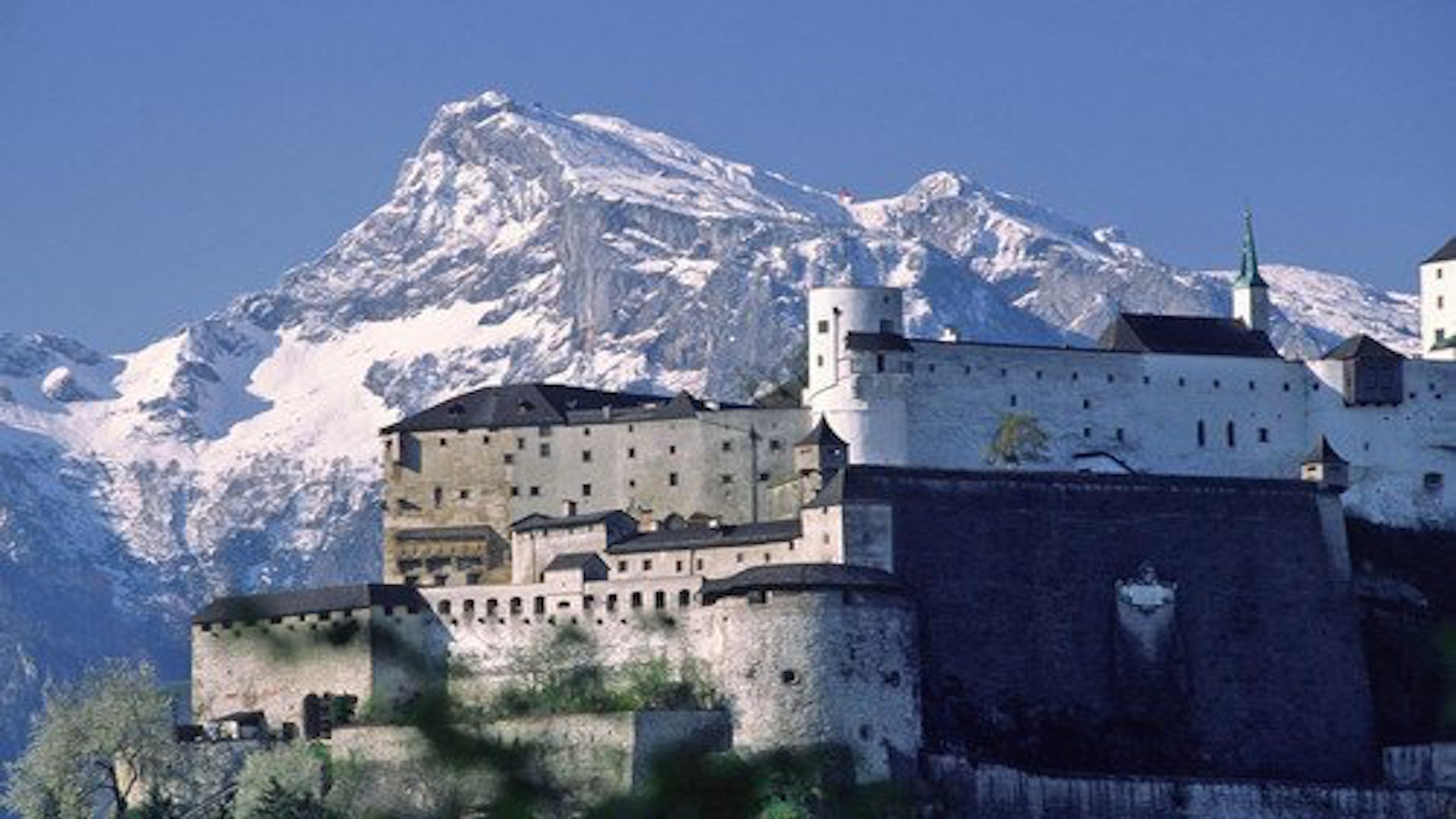
![]()
**St. Peters Cemetery & Catacombs
cemetery open daily
Summer 6:30am – 7pm Winter 6:30am – 5:30pm free admission
catacombs open daily May – September 10am – 12:30pm & 1pm – 6pm October – April 10am – 12:30pm & 1pm – 5pm admission €1.50 – €2.00
Website https://www.salzburg.info/en/sights/churches-cemeteries/st-peters-monastery-cemetery
Located at the bottom of the footpath that lead to the fortress, St. Peters Cemetery or Petersfriedhof is the oldest cemetery in Salzburg. You may also recognize it as one of the many backdrops from the movie “The Sound of Music”! The complex which also includes St. Peters Abbey and catacombs are home to the oldest community of monks in the German-speaking world. The elaborate and decorative headstones along with the serenity of the grounds are worth a walk through. You can get a good feel for the cemetery in about 10 minutes if time is short.
If you have more time you will find early Christian catacombs, which date from around 15 A.D carved into the walls of the large rock that provides shelter to the cemetery. Look for the staircase carved into the rock, they will lead you to the catacombs. The main highlight once you enter is the 1178 Gertrauden Chapel. If you have time and are a fan of Rococo decor, peek your head into the Abbey, which is open most of the day except during mass.
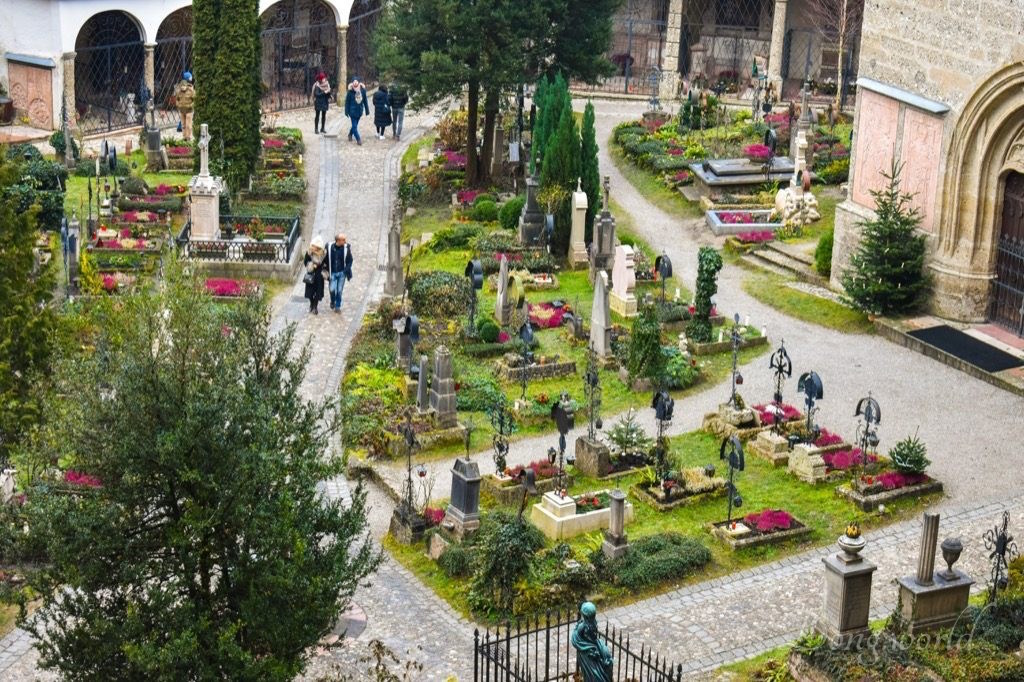
![]()
**Salzburg Cathedral
open daily May – September 8am – 7pm Monday-Saturday & 1pm – 7pm Sunday October – April 8am – 6pm Monday-Saturday & 1pm – 6pm Sunday Times can vary due to services or concerts.
admission is free
website http://www.salzburger-dom.at/en/home/
The Baroque Catholic cathedral, dedicated to St. Rupert you see today was completed in 1628, but a church has existed here since 774. The beautiful double towered facade dates from the 1660’s and dominates the center of the Baroque old town. Two of the cathedrals seven bells survived several fires and both World Wars and date from the 17th century. Touring inside you see a magnificent example of the opulence of the period. The mostly white interior provides a wonderful contrast to the beautiful ceiling art and many paintings. You will also notice that there are two organs, one at each end of the cathedral. Fun fact…Mozart was baptized here in 1756!
*If at this point in your day your looking for a nice break and a great meal with a traditional setting Zipher Bierhaus Schwarz is along your way from Salzburg Cathedral to the next stop on this tour. Look ahead to this sections Restaurants suggestions for more information.
*If your lucky enough to be in Salzburg during the Christmas Season take the time to stroll the Christkindlmarkt (Christmas Market) and get a warm cup of glühwein (spiced red wine). Its located right in front of the cathedral.
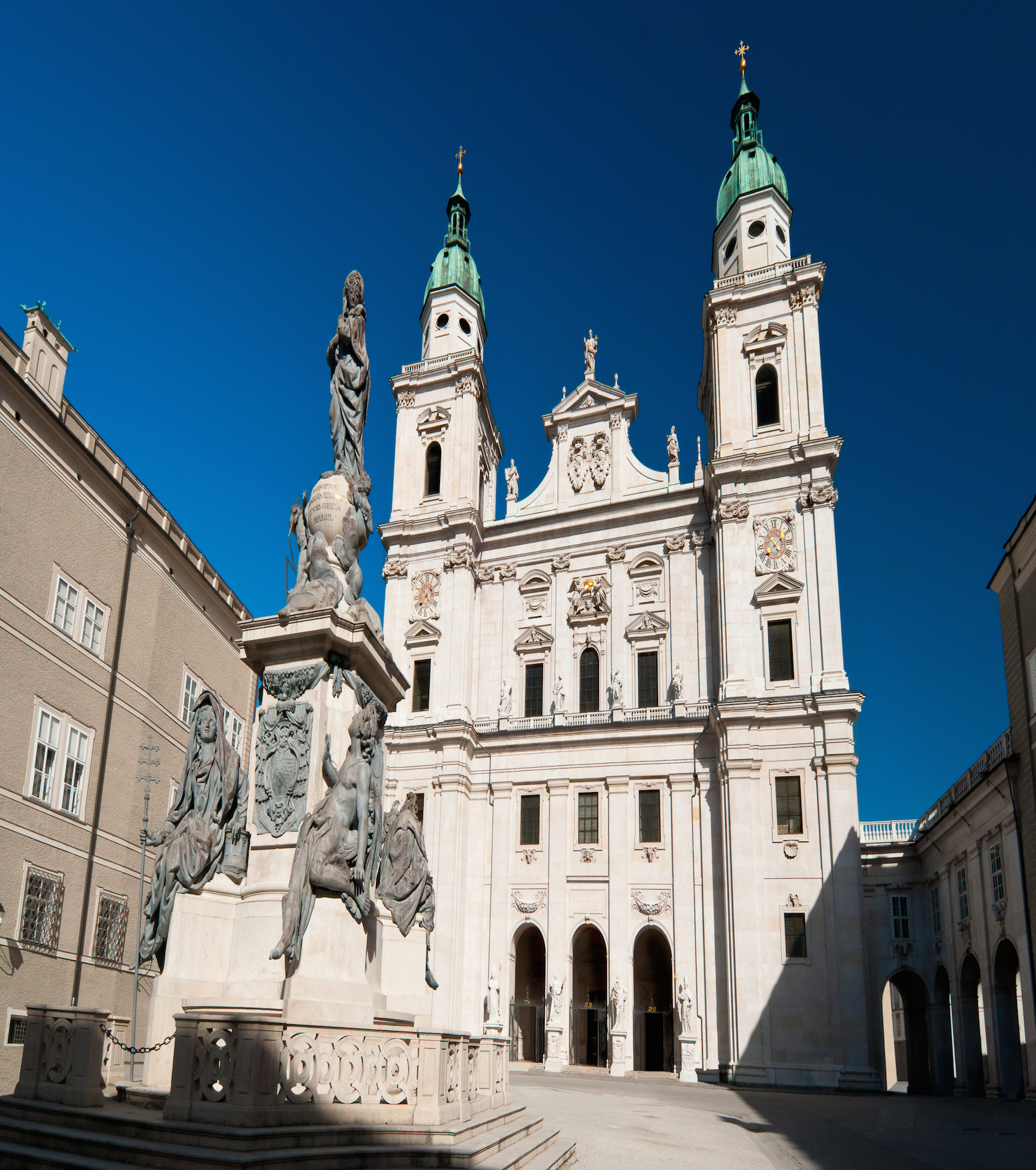
![]()
**Mozarts Birthplace & Getreidegasse
open daily (last entry 30 min before closing) July – August 8:30am – 7pm September – June 9am – 5:30pm
admission €3.50 children – €12.00 adults, age 6 and under are free
Website https://mozarteum.at/en/museums/mozarts-birthplace/
Look for the bright yellow Baroque building amongst the high townhouses located on the historical pedestrian zone at Getreidegasse 9 A-5020. Getreidegasse is Salzburg’s most idilic shopping lane. Mozart Geburtshaus, (Mozart’s Birthplace) and museum is dedicated to all things Mozart. He lived here until age 17 and guests will learn about his personal life and passion for music as well as his love for opera. Six of his instruments are on display, along with his original handwritten music sheets. A nice peek into not only the musician but also 18th century Salzburg. Even if you decide not to visit the museum be sure to take in this picturesque old town shopping street. Take note of each of its shops traditional wrought iron guild signs, which describe the types of items shoppers will find inside.
*For the last two stops of the tour we head across the Salzach river via the Makartsteg footbridge and into Salzburg’s neustadt (new town)!
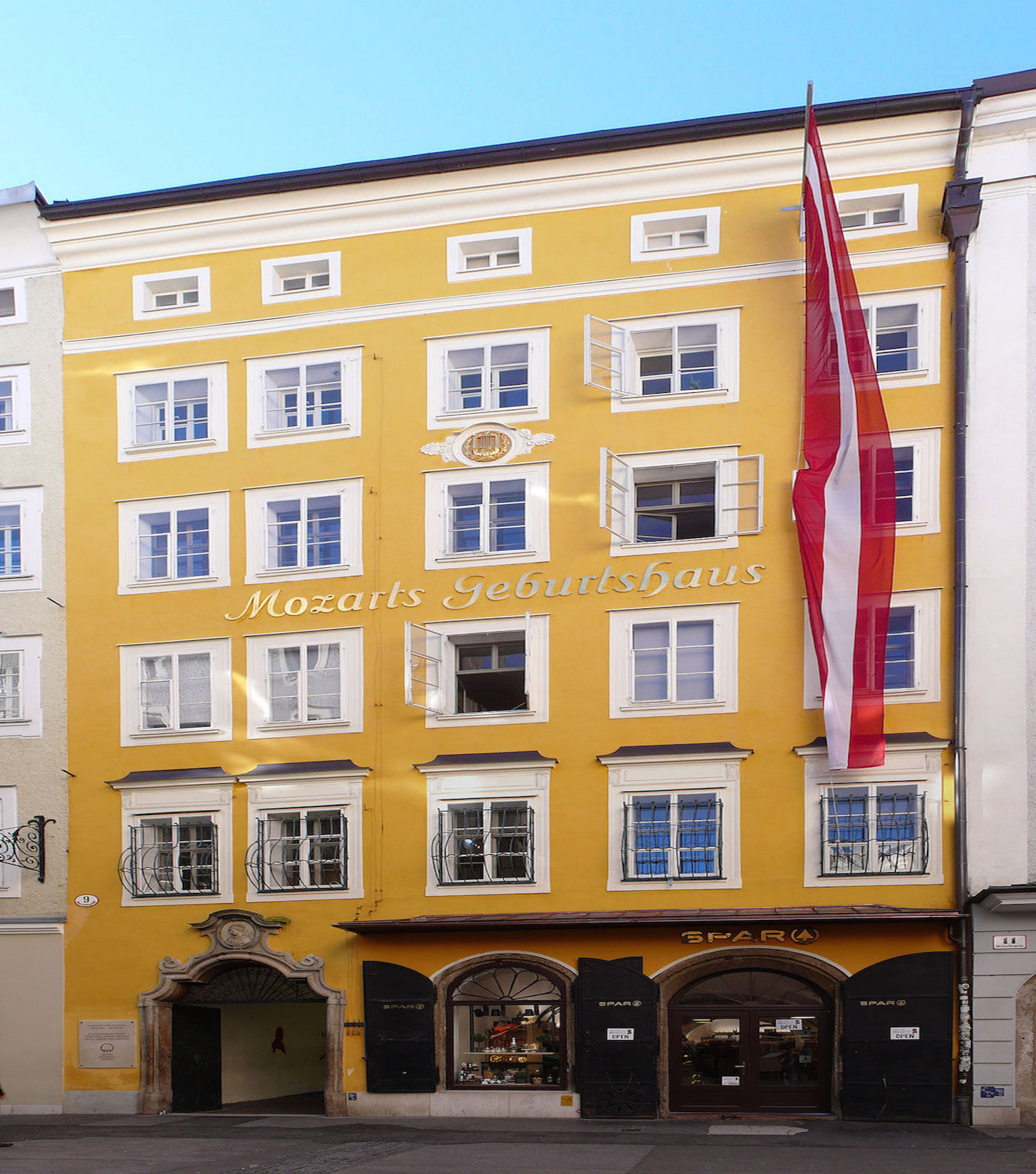
![]()
**Mirabelle Gardens and Palace
Gardens open daily from 6am – dusk Palace open daily from 8am to 6pm
admission is free to both the gardens and palace
website: https://www.salzburg.info/en/sights/top10/mirabell-palace-gardens
Sound of Music fans be sure to tour the gardens, as this was one of the most memorable backdrops in the movie. The Baroque gardens you see today were completed in 1690, and the original geometric design from the period is still clearly visible. Highlights include the Pegasus Fountain, Palace Chapel that was consecrated in 1726, and the Ornamental Rose Garden. You may remember Maria dancing around the Pegasus Fountain in Sound of Music singing “Do Re Mi”!
If you only tour on or the other; gardens or the palace, my vote…gardens! If the weather does not allow then tour the palace.
Mirabelle Palace was originally built as a pleasure palace by Prince-Archbishop Raitenau in 1606 for his mistress. Just 6 years later the Prince-Archbishop would be deposed and arrested at Hohensalzburg Castle and his mistress was expelled. This tour just came full circle! The palace was purchased in 1866 by the city of Salzburg and now serves as a municipal building and the mayors office. It is also the backdrop for many beautiful weddings. You can see the interior and quickly walk through the building in about 15 minutes.
*The last stop on this tour is a well deserved treat! Make your way back towards the footbridge.
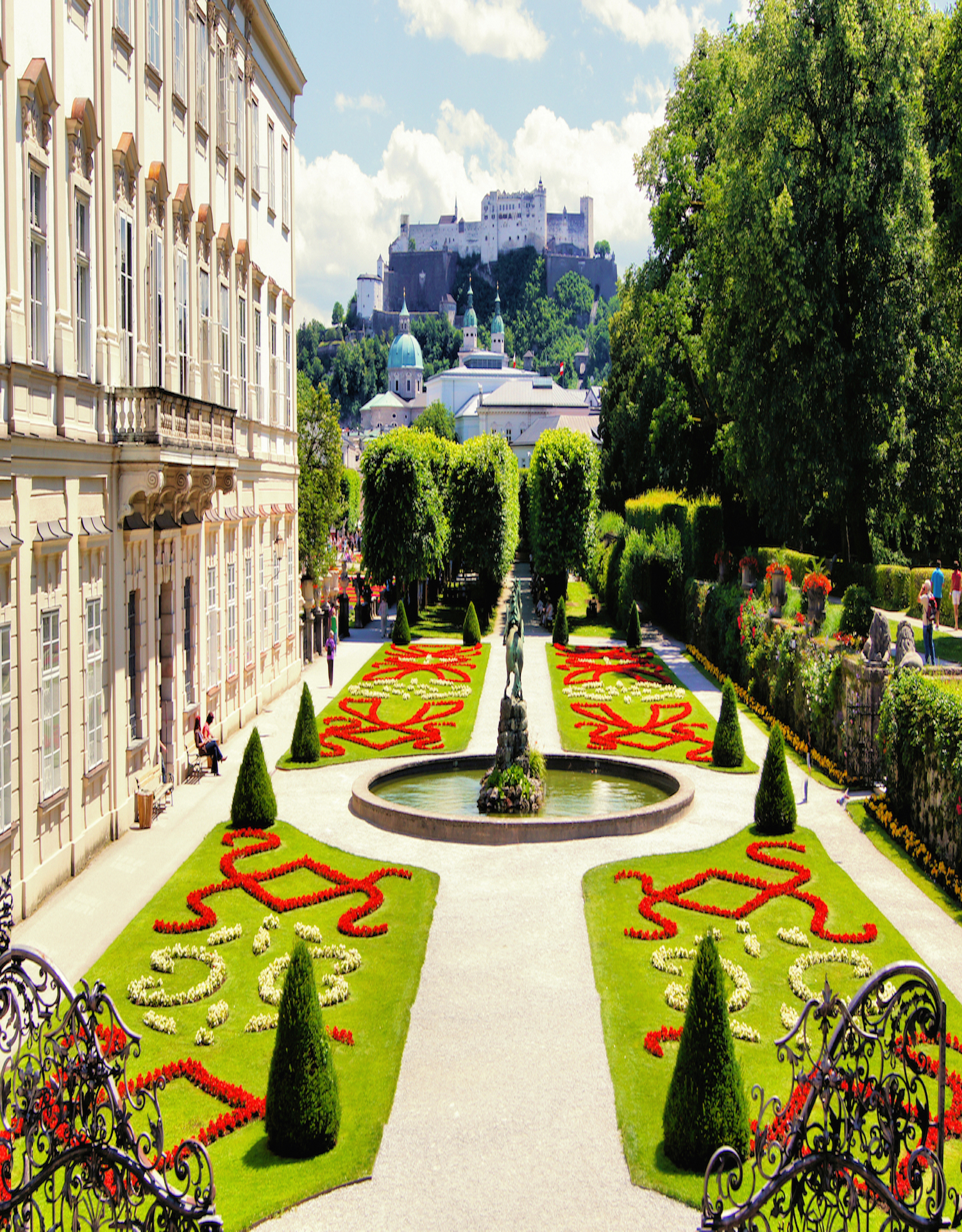
![]()
***Petit France
was to defend the city from attack. It did so successfully in 1870, during the Franco-Prussian War, by raising the water level on the River Ill, flooding the land south of the city, and literally holding off the enemy with a “barrage” of water, making the area impassible. Visitors can take in very nice views ofPetit France and the Ponts Couverts from the terrace. There are also some sculptures you can take a peek of inside. On different occasions throughout the year the dam is lit up nicely at night in colored lights.

Other Salzburg & Around Sites
Other Important/significant Sites/ things to do off the path of walking tour that are not included in walk of City

German Quarter
The area across the canal and east of the Grande Île encompasses the late 19th century German Quarter or Quartier Allemande. Large buildings such as The Palace of the Rhine and The National Theater are what remains of Imperial Germany. Today the buildings that once represented German power, define a resilient city and function as part of the modern cultural landscape of Strasbourg. If you are visiting the city for more than a day, the cities new town German Quarter is worth strolling.
The following sites are all within the German Quarter and in close proximity to one another.
![]()
Place de la République – German Quarter
On the border between the historic Grande Île and the new town, is Place de la République, originally designed as the German Kaiserplatz, or Imperial Square. Completed in 1887, this area symbolized the new German power that now reigned over the city or Strasbourg. It’s first run as a German platz, came to an end in 1919, when it became a place, after the return of Alsace-Lorraine to the French. In 1940, during the second German annexation it was given a new nameBismarckplatz. Finally, in 1945 it returned to being French again and was renamed one last time, Place de la République. Today it is a symbol epitomized by the beautiful monument that dominates its central garden square. On it is an inscription that simply reads, “to our dead”, a poignant reminder of the human cost of war.

![]()

Strasbourg National Theater – German Quarter
website: www.tns.fr
Situated on the Place de la République is Strasbourg’s National Theater. The neoclassical building was constructed in 1892 and housed the legislative assembly under German controlled Alsace and Lorraine. In 1919 the building was offered by the city to the Strasbourg Music Conservatory. Subsequent bombing in World War II destroyed the east wing, it was rebuilt as theater auditorium, which opened as such in 1957. Today’s theater was established in 1968 and is the only theater of its kind in Alsace. During the theater season fifteen shows are put on by both the in-house company as well as visiting companies. Seeing a performance in this massive building is both culturally and historically exciting.
![]()
**Church of St. Paul
Situated on an island on the River Ill, The Protestant Reform Church of St. Paul dominates the new town with its 250 foot, high spires. A beautiful example of Gothic Revival Architecture, it was completed in 1897. The church, like many of the buildings in this part of Strasbourg, was built by Imperial Germany. Its congregation was made up of the army generals and soldiers that were stationed in the city. Its 19 portals, a lot for a church of its size, were each designated and used only by rank, from generals down to foot soldiers.

![]()

**Parc de l’Orangerie
A beautiful 17th century park with a lake, great for jogging, strolling and birdwatching. Storks, which are symbolic of Alsace, can be seen. Depending on the season, there may even be canoeing available and an indoor bowling alley is open all year. The flower filled park has playgrounds and a free zoo for kids, which is open daily, year around. making this a MUST DO spot for families. Also, the gourmet restaurant Buerehiesel, is located in a 17th century farmhouse inside the park, which I include in the “Strasbourg Restaurants” section with a full description.
![]()
European Union Building
open to the public only when parliament is in session admission is free, must be at least 14 years of age to enter
website: europarl.europa.eu
Located about a mile and a half from the old town and only a half mile from Parc de l’Orangerie is the European Union Building. It’s a beautiful modern building representing the largest transnational parliament in the world. Its architecture is evocative of the direction in which the EU sees itself going, towards the future. Inside, the Hemicircle can seat all 785 members of the Parliament. You will notice the tower has a “half finished” look, it is actually part of the design, meant to remind the members of Parliament of the work that still needs to be done to unite all of Europe. The tower is rumored to be modeled after a painting by Bruegel, Tower of Babel, oddly it does bear a striking resemblance. Its main entrance makes for a great photo amid the flags of each EU country. Its glass construction reflects nicely on the River Ill, the bridge connecting it to the other side of the river leads to the Winston Churchill Building. The only way to gain entrance is to attend a session of the assembly, which must be reserved in advance. The spots are limited and only available when Parliament is in session. The website calendar lists the days (highlighted in blue) when the assembly is in session and how to gain access.

Salzburg & Around Hotels

$$$ Restaurant Buerehiesel
Tucked inside the center of the park is the Michelin rated Restaurant Buerehiesel, housed inside of a 17th century half-timbered farmhouse, which was moved from another part of the city and brought into the park in 1895.
TIP… The restaurants three-course business lunch menu offers the same great experience for €35. Reservations are recommended for lunch and dinner.

$$$ Restaurant Buerehiesel
Tucked inside the center of the park is the Michelin rated Restaurant Buerehiesel, housed inside of a 17th century half-timbered farmhouse, which was moved from another part of the city and brought into the park in 1895.
TIP… The restaurants three-course business lunch menu offers the same great experience for €35. Reservations are recommended for lunch and dinner.

$$$ Restaurant Buerehiesel
Tucked inside the center of the park is the Michelin rated Restaurant Buerehiesel, housed inside of a 17th century half-timbered farmhouse, which was moved from another part of the city and brought into the park in 1895.
TIP… The restaurants three-course business lunch menu offers the same great experience for €35. Reservations are recommended for lunch and dinner.

$$$ Restaurant Buerehiesel
Tucked inside the center of the park is the Michelin rated Restaurant Buerehiesel, housed inside of a 17th century half-timbered farmhouse, which was moved from another part of the city and brought into the park in 1895.
TIP… The restaurants three-course business lunch menu offers the same great experience for €35. Reservations are recommended for lunch and dinner.
![]()
Salzburg & Around Restaurants

$$$ Restaurant Buerehiesel
Tucked inside the center of the park is the Michelin rated Restaurant Buerehiesel, housed inside of a 17th century half-timbered farmhouse, which was moved from another part of the city and brought into the park in 1895.
TIP… The restaurants three-course business lunch menu offers the same great experience for €35. Reservations are recommended for lunch and dinner.

$$$ Restaurant Buerehiesel
Tucked inside the center of the park is the Michelin rated Restaurant Buerehiesel, housed inside of a 17th century half-timbered farmhouse, which was moved from another part of the city and brought into the park in 1895.
TIP… The restaurants three-course business lunch menu offers the same great experience for €35. Reservations are recommended for lunch and dinner.

$$$ Restaurant Buerehiesel
Tucked inside the center of the park is the Michelin rated Restaurant Buerehiesel, housed inside of a 17th century half-timbered farmhouse, which was moved from another part of the city and brought into the park in 1895.
TIP… The restaurants three-course business lunch menu offers the same great experience for €35. Reservations are recommended for lunch and dinner.

$$$ Restaurant Buerehiesel
Tucked inside the center of the park is the Michelin rated Restaurant Buerehiesel, housed inside of a 17th century half-timbered farmhouse, which was moved from another part of the city and brought into the park in 1895.
TIP… The restaurants three-course business lunch menu offers the same great experience for €35. Reservations are recommended for lunch and dinner.
Hallstatt
At the heart of this busy university city is its soul, Strasbourg’s old town center, or Grande IÎe and its most popular historic quarter Petit France, are not to be missed. Surrounded by the waterways of the River Ill, and chalk full of timbered medieval buildings, every inch of this pedestrian friendly cobbled zone is picture perfect Franco Germanic charm. The main attractions, hotels and fantastic restaurants are all within walking distance in and around the old town.
TIP.. Le Petit France area is charming, and the hotels are great, however be sure to search for restaurants off the beaten path, there are oodles of hidden gems.
*formal seat of the European Union
*home to France’s largest university
*its old town was given UNESCO World Heritage Site status in 1988
*located on the west bank of the Rhine River
*all museums are free in the city on the first Sunday of each month
Self-Guided Walking Tour of Hallstatt
This tour begins at Place Kléber and at a comfortable pace lasts approximately 4-6 hours, depending on duration of stops. Without stopping, not going inside of any of the sites and just some picture taking, the walk can be completed in about an hour and a half. This tour can be done in reverse depending on your most convenient starting location.
***Place Kléber
Strasbourg’s biggest square is at the heart of the Grande IÎe and makes a great starting point for seeing the sights within and around the old town center. If you’re here during the Christmas Markets, there is a big beautiful tree that lights up the whole square. In the center of this large open space is a statue and a vault containing the remains of General Jean-Baptiste Kléber, the squares namesake. Many of my favorite restaurants are located on the pedestrian streets between here and the cathedral. This is a great area for lunch or to come back to for dinner. For the purposes of my walk Place Kléber will be either the beginning or ending point of the self-guided walking tour.
Place Kléber is also a great place to begin if you want to walk to the sights just outside to the northeast of the Grande IÎe, such as the European Union and Place de République which I include in the “Other Strasbourg Sites” section.

![]()
***Strasbourg Cathedral
open daily, except during mass
Admission €4.40 adults, €2.20 children 5-17 and students
Steps up to viewing platform additional €5
Website cathedrale-strasbourg.fr
The dramatic Cathedral of Our Lady is a MUST DO! It’s France’s second most visited cathedral after Paris’ Notre Dame and is Strasbourg’s most popular site. The Roman Catholic Cathedral was erected in 1439. Complete with stained glass and supported by its graceful flying buttresses, it’s one of the best examples of late Gothic architecture in Europe. The soaring spire rising from its medieval square, can be seen from miles away. Sandstone quarried from the nearby Vosges Mountains was used in its construction, casting a delicate texture to its structure and tableau of pink on its exterior.
Walking around inside take special notice of the stained glass, most is from the 13th and 14th century, some (located on the left side in the transept as you enter the front of the cathedral) dates from the 12th century! At the opposite side of the transept, (right as you walk in), you will see The Pillar of the Angels, Le Pilier Des Agnes, a column displaying beautiful 13th century statuary. Also, here is a sixty-foot astronomical clock from the 15th century, which performs it greatest series of chimes each day at 12:30p.m. The clock plays a simpler chime every 15 minutes. Its special dials display the positions of the moon, sun and stars, clocks like these helped determine seasonal equinoxes, leap years and even where Easter fell in the Christian calendar with great accuracy. Also, worth noting is the cathedrals suspended pipe organ and ornate 15th century pulpit.
If you don’t mind the climb, the view at the top of the spires over 300 steps, is well worth the effort. The medieval center surrounds you from below, the Rhine flows past and the iconic Black Forest can be seen in the east, where France meets Germany.
TIP… The cathedral is most crowded around noon when tour operators spill in to see the fanfare of the 12:30 clock chime.

![]()
**Palais de Rohan
open every day except Mondays, Tues-Fri 9am-5pm (closed for lunch from 12noon-2pm), Sat-Sun open all day 9am-6pm
admission €6 per museum or €12 for all three
website: musees.strasbourg.eu
A masterpiece of French Baroque architecture, Palais de Rohan was completed in 1742 as the residence for the prince-bishops and cardinals to the noble House of Rohan. Its imposing size and religious statues were meant to celebrate the return of Catholicism to Strasbourg after two centuries of Protestant domination. Since the end of the 19th century it has housed Strasbourg’s Archaeological, Fine Art, and Decorative Arts museums. You will want to take a few minutes to check out the striking exterior of this building which epitomizes the best of French architecture.
It’s right near the Cathedral, making it convenient to do both. Visiting the museums depends on timeframe and your appetite for museums. If you do decide to dive in, I like the Fine Art Museum, look for beaux-arts, the museum elegantly presents works by Memling, Botticelli, Raphael, El Greco, Reubens and more. The Decorative Arts Museum is great if you haven’t yet visited a chateau, and love period furiniture.

![]()
**Alsatian Museum
open every day except Tuesdays
noon-6pm, Sundays 10am-6pm
Admission €4
Located just across the river from Palais de Rohan is the Alsatian Museum, dedicated to all things Alsatian. Traditional folk art, furniture, religious and everyday artifacts are all housed in Strasbourg’s oldest house, which lends itself well to the flow of the exhibits, and makes the overall experience especially authentic. Some 30 rooms all have different themes representing the various Alsatian regions. Excellent audio guide included.

![]()
**Cave Historique Des Hospices de Strasbourg
open daily, except Sundays hours 8:30-5:30 (closed for lunch noon-1:30)
Saturdays limited hours 9am-12:30pm only
admission is free, audio guide €3
website: vins-des-hospices-de-strasbourg.fr
This stop offers a unique experience of visiting a wine cellar in the city. The historic cellars have kept cool and dry under the cities civil hospital since 1395. Inside are some of the oldest wine barrels in the world and one of the world’s oldest wines from 1472. Rows of wine barrels and the overall atmosphere provide great photo ops. The audio guide is great if you want to spend more time on the history of the hospital and how the cellar came about.
TIP… If you’re lucky you will hit the cellar on a special wine tasting day to sample new wines from the region. Contact them directly to find out the tasting schedule, or ask your hotel to do it for you.

![]()
***Petit France
was to defend the city from attack. It did so successfully in 1870, during the Franco-Prussian War, by raising the water level on the River Ill, flooding the land south of the city, and literally holding off the enemy with a “barrage” of water, making the area impassible. Visitors can take in very nice views ofPetit France and the Ponts Couverts from the terrace. There are also some sculptures you can take a peek of inside. On different occasions throughout the year the dam is lit up nicely at night in colored lights.

Other Hallstatt Sites
Other Important/significant Sites/ things to do off the path of walking tour that are not included in walk of City

German Quarter
The area across the canal and east of the Grande Île encompasses the late 19th century German Quarter or Quartier Allemande. Large buildings such as The Palace of the Rhine and The National Theater are what remains of Imperial Germany. Today the buildings that once represented German power, define a resilient city and function as part of the modern cultural landscape of Strasbourg. If you are visiting the city for more than a day, the cities new town German Quarter is worth strolling.
The following sites are all within the German Quarter and in close proximity to one another.
![]()
Place de la République – German Quarter
On the border between the historic Grande Île and the new town, is Place de la République, originally designed as the German Kaiserplatz, or Imperial Square. Completed in 1887, this area symbolized the new German power that now reigned over the city or Strasbourg. It’s first run as a German platz, came to an end in 1919, when it became a place, after the return of Alsace-Lorraine to the French. In 1940, during the second German annexation it was given a new nameBismarckplatz. Finally, in 1945 it returned to being French again and was renamed one last time, Place de la République. Today it is a symbol epitomized by the beautiful monument that dominates its central garden square. On it is an inscription that simply reads, “to our dead”, a poignant reminder of the human cost of war.

![]()

Strasbourg National Theater – German Quarter
website: www.tns.fr
Situated on the Place de la République is Strasbourg’s National Theater. The neoclassical building was constructed in 1892 and housed the legislative assembly under German controlled Alsace and Lorraine. In 1919 the building was offered by the city to the Strasbourg Music Conservatory. Subsequent bombing in World War II destroyed the east wing, it was rebuilt as theater auditorium, which opened as such in 1957. Today’s theater was established in 1968 and is the only theater of its kind in Alsace. During the theater season fifteen shows are put on by both the in-house company as well as visiting companies. Seeing a performance in this massive building is both culturally and historically exciting.
![]()
**Church of St. Paul
Situated on an island on the River Ill, The Protestant Reform Church of St. Paul dominates the new town with its 250 foot, high spires. A beautiful example of Gothic Revival Architecture, it was completed in 1897. The church, like many of the buildings in this part of Strasbourg, was built by Imperial Germany. Its congregation was made up of the army generals and soldiers that were stationed in the city. Its 19 portals, a lot for a church of its size, were each designated and used only by rank, from generals down to foot soldiers.

![]()

**Parc de l’Orangerie
A beautiful 17th century park with a lake, great for jogging, strolling and birdwatching. Storks, which are symbolic of Alsace, can be seen. Depending on the season, there may even be canoeing available and an indoor bowling alley is open all year. The flower filled park has playgrounds and a free zoo for kids, which is open daily, year around. making this a MUST DO spot for families. Also, the gourmet restaurant Buerehiesel, is located in a 17th century farmhouse inside the park, which I include in the “Strasbourg Restaurants” section with a full description.
![]()
European Union Building
open to the public only when parliament is in session admission is free, must be at least 14 years of age to enter
website: europarl.europa.eu
Located about a mile and a half from the old town and only a half mile from Parc de l’Orangerie is the European Union Building. It’s a beautiful modern building representing the largest transnational parliament in the world. Its architecture is evocative of the direction in which the EU sees itself going, towards the future. Inside, the Hemicircle can seat all 785 members of the Parliament. You will notice the tower has a “half finished” look, it is actually part of the design, meant to remind the members of Parliament of the work that still needs to be done to unite all of Europe. The tower is rumored to be modeled after a painting by Bruegel, Tower of Babel, oddly it does bear a striking resemblance. Its main entrance makes for a great photo amid the flags of each EU country. Its glass construction reflects nicely on the River Ill, the bridge connecting it to the other side of the river leads to the Winston Churchill Building. The only way to gain entrance is to attend a session of the assembly, which must be reserved in advance. The spots are limited and only available when Parliament is in session. The website calendar lists the days (highlighted in blue) when the assembly is in session and how to gain access.

Hallstatt Hotels & Restaurants

$$$ Restaurant Buerehiesel
Tucked inside the center of the park is the Michelin rated Restaurant Buerehiesel, housed inside of a 17th century half-timbered farmhouse, which was moved from another part of the city and brought into the park in 1895.
TIP… The restaurants three-course business lunch menu offers the same great experience for €35. Reservations are recommended for lunch and dinner.

$$$ Restaurant Buerehiesel
Tucked inside the center of the park is the Michelin rated Restaurant Buerehiesel, housed inside of a 17th century half-timbered farmhouse, which was moved from another part of the city and brought into the park in 1895.
TIP… The restaurants three-course business lunch menu offers the same great experience for €35. Reservations are recommended for lunch and dinner.

$$$ Restaurant Buerehiesel
Tucked inside the center of the park is the Michelin rated Restaurant Buerehiesel, housed inside of a 17th century half-timbered farmhouse, which was moved from another part of the city and brought into the park in 1895.
TIP… The restaurants three-course business lunch menu offers the same great experience for €35. Reservations are recommended for lunch and dinner.

$$$ Restaurant Buerehiesel
Tucked inside the center of the park is the Michelin rated Restaurant Buerehiesel, housed inside of a 17th century half-timbered farmhouse, which was moved from another part of the city and brought into the park in 1895.
TIP… The restaurants three-course business lunch menu offers the same great experience for €35. Reservations are recommended for lunch and dinner.

